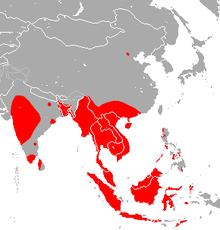| Black-bearded tomb bat | |
|---|---|

| |
| male with prominent black beard | |
| Conservation status | |
 Least Concern (IUCN 3.1) | |
| Scientific classification | |
| Domain: | Eukaryota |
| Kingdom: | Animalia |
| Phylum: | Chordata |
| Class: | Mammalia |
| Order: | Chiroptera |
| Family: | Emballonuridae |
| Genus: | Taphozous |
| Species: | T. melanopogon |
| Binomial name | |
| Taphozous melanopogon Temminck, 1841 | |

| |
| Black-bearded Tomb Bat range | |
| Synonyms | |
| |
The black-bearded tomb bat (Taphozous melanopogon) is a species of sac-winged bat found in South and South East Asia.
Taxonomy and etymology
It was described as a new species in 1841 by Dutch zoologist Coenraad Jacob Temminck. The holotype was collected on Java. Its species name "melanopogon" comes from Ancient Greek "mélās" meaning "black" and "pṓgōn" meaning "beard".
Description
The black-bearded tomb bat has a forearm length of 55–68 mm (2.2–2.7 in). It has a small "beard", or a tuft of black fur on its chin. Its fur is blackish-brown, with individual hairs white at the base.
Biology and ecology
The black-bearded tomb bat is highly colonial, forming large aggregations of up to 15,000 individuals while roosting. These roosts are located in temples, ruins, or caves. It is a seasonal breeder; young are born after a gestation length of 120–125 days. The typical litter size is one individual, though twins have been documented.
Range and habitat
This species ranges widely throughout Asia and Southeast Asia. Its range includes the following countries: Brunei, Cambodia, China, India, Indonesia, Laos, Malaysia, Myanmar, Philippines, Singapore, Sri Lanka, Thailand, Timor-Leste, and Vietnam. It has been documented at elevations up to 800 m (2,600 ft) above sea level.
See also
References
- ^ Phelps, K.; Csorba, G.; Bumrungsri, S.; Helgen, K.; Francis, C.; Bates, P.; Gumal, M.; Balete, D.S.; Heaney, L.; Molur, S.; Srinivasulu, C. (2019). "Taphozous melanopogon". IUCN Red List of Threatened Species. 2019: e.T21461A22110277. doi:10.2305/IUCN.UK.2019-3.RLTS.T21461A22110277.en. Retrieved 14 November 2021.
- Temminck, C. J. (1841). Monographies de mammalogie. Vol. 2. G. Dufour et E. d'Ocagne, 1841. pp. 287–289.
- Srinivasulu, C (2019). South Asian mammals: an updated checklist and their scientific names. CRC Press. p. 125. ISBN 978-0-429-88089-6. Retrieved 2019-08-30.
- ^ Smith, Andrew T; Xie, Yan; Hoffmann, Robert S; Gemma, Federico (2013). Mammals of China. Princeton, N.J.: Princeton University Press. ISBN 978-0-691-15427-5.
| Taxon identifiers | |
|---|---|
| Taphozous melanopogon | |
- IUCN Red List least concern species
- Taphozous
- Bats of Asia
- Bats of South Asia
- Bats of Southeast Asia
- Bats of Borneo
- Bats of China
- Bats of India
- Bats of Indonesia
- Bats of Malaysia
- Bats of the Philippines
- Mammals of Bangladesh
- Mammals of Brunei
- Mammals of Cambodia
- Mammals of Laos
- Mammals of Myanmar
- Mammals of Singapore
- Mammals of Sri Lanka
- Mammals of Timor
- Mammals of Thailand
- Mammals of Vietnam
- Fauna of Sumatra
- Least concern biota of Asia
- Mammals described in 1841
- Taxa named by Coenraad Jacob Temminck